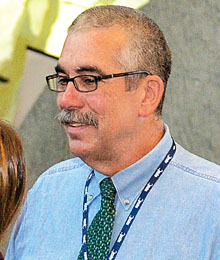 Tom Dodd is vice president of the Lake Placid Education Association. A technology specialist and former teacher, Dodd is one of the founders of the annual Adirondack Youth Climate Summit, held in November at the Natural History Museum in Tupper Lake.
Tom Dodd is vice president of the Lake Placid Education Association. A technology specialist and former teacher, Dodd is one of the founders of the annual Adirondack Youth Climate Summit, held in November at the Natural History Museum in Tupper Lake.
1. How has the Youth Climate Summit evolved?
The summit was started in 2008 after a national climate conference at the museum. It's now part of a year-round initiative called the Adirondack Youth Climate Program that promotes student leadership; collaboration with the Adirondack farm-to-school initiatives and climate workshops for middle school students. It also helps school green teams kick off small projects.
2. Who attends the summit?
Student teams from 25 high schools and seven universities come from New York, Vermont and Connecticut. The focus of our work is to teach students how to work within school systems to effect change.
3. How does the summit promote solidarity?
Teachers and students from Tupper Lake, Lake Placid and Saranac Lake work collaboratively to generate solutions to common obstacles. By working together we all achieve more.
4. How does the youth climate program fit in with STEM?
A great example is a collaboration between Lake Placid High School environmental science teacher Tammy Morgan and Adirondack Educational Center conservation resources teacher Christian Wissler. Students and teachers learned about the production of biodiesel at the summit. Through a soil and water conservation grant, the conservation resource students built a biodiesel manufacturing system and produce biodiesel in their classroom; culinary students donate used cooking oil; auto-tech students are researching ways to adapt onsite vehicles to run on biodesel; and cosmetology students are exploring how to make glycerin soaps from the by-products. Students are solving real-world problems, working in teams and applying STEM knowledge.
5. What are some of the results of the climate program?
Student-led recycling campaigns are springing up across the region. Students help maintenance crews create “no mow” zones to promote biodiversity and decrease the use of fossil fuel. Students and teachers participate in farm-to-school efforts. They raise funds to install water bottle filling stations and distribute reusable water bottles in schools. Students promote “Ban the Bag” efforts to distribute reusable grocery bags, and post videos about climate change and their work on the Internet to reach a larger audience.
For more information, visit www.adkyouthsummit.org/.